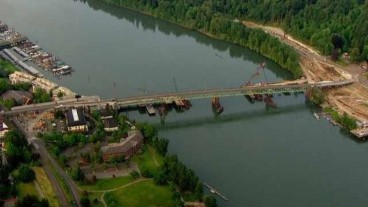Types of bridges

Contents [show]
- Arch Bridge
An arch bridge is a type of bridge that uses a curved, semi-circular structure, known as an arch, to span an obstacle. The function of an arch bridge involves transmitting the force of gravity, which is exerted downward, inward towards the center of the structure, and towards a central stone known as the keystone, instead of directly downwards. When a load is applied to the deck, it transfers the weight to the arch, which distributes the force evenly to its supports or abutments at each end. This allows the arch bridge to span a long distance and carry heavy loads without the fear of collapse.
Fixed arch bridges can be destabilized by temperature changes. For this purpose, the arch design is, sometimes, altered by adding hinges at each base and even at the center of the span. When temperatures are modified, the materials of the bridge can expand or contract, creating stress on the structure. However, by utilizing multiple arches with smaller spans instead of a single, longer arch, the bridge can better handle these changes.

- Beam Bridge
Remaining the most cost-effective and simple option, the beam bridge was the first type of bridge constructed. It consists of a crossbeam spanning the distance between two abutments. A variation of this design is the girder bridge, which utilizes steel girders for additional support. By adding piers or stanchions in the middle and connecting sections between them, a longer and more stable beam bridge can be constructed.
In beam bridges, the compression force pushes the load inward onto the piers in the center of the bridge, while the tension force pulls the load outward toward the abutments at each end of the structure. This distribution of forces keeps the beam bridge stable and prevents the materials from buckling or other failure options under the imposed loading.

- Cantilever Bridge
Cantilever construction technique is used for certain types of bridges, where a vertical pillar is anchored into the ground to support a horizontal deck extending out from one or both sides across the span. The load is usually supported from both above and below, and a good example of this type of construction is a diving board or platform.
In cantilever bridges, trusses are often employed for additional support. The bridge truss assists in transferring the load away from the deck and onto the supporting piers and abutments, which helps the cantilevers to withstand the tension in the upper supports and the compression in the lower supports. This structural design increases the stability and strength of cantilever bridges.

- Suspension Bridge
A suspension bridge is constructed using vertical pillars or pylons connected by suspension cables. The bridge deck is held up by smaller, vertical suspenders attached to the main cables, utilizing tension as the primary force that maintains the stability of suspension bridges.
Furthermore, suspension bridges are also susceptible to torsion, which is a twisting force that is often caused by environmental factors such as wind. Torsion can cause dangerous movement, and if the surface of the bridge twists excessively while people are traveling on it, they may be thrown off.
Shear is another type of force that can affect suspension bridges, and it occurs when environmental forces apply pressure in opposite directions on a single, fastened part of the bridge, causing it to break like a stick between two hands. These forces can have both vertical and horizontal effects on suspension bridges, which can be a potential safety concern.

- Cable-Stayed Bridge
A cable-stayed bridge is a type of bridge that is similar to a suspension bridge, but instead of a main cable, it connects the crossbeam or bridge deck directly to pillars or towers. Instead of a single cable, a large number of vertical suspenders are fixed to the top of the tower, which are responsible for holding up the bridge deck through tension. This design helps to keep the bridge deck stable and in place, and it differs from the traditional suspension bridge in its method of support.

- Tied-Arch Bridge
A tied-arch bridge is a type of bridge that combines characteristics of both arch bridges and suspension bridges. Like a regular arch bridge, it uses horizontal thrust from both sides to support an arched structure. However, instead of having an arch that supports the structure from below, the arch in a tied-arch bridge rises above the road or deck. Vertical ties descend from the arch to increase the support of the decking, which is similar to the use of cables in a suspension bridge. This design allows for longer spans than traditional arch bridges and provides a unique aesthetic appearance, which can make it a landmark or architectural feature.

- Truss Bridge
A truss bridge is constructed by connecting a series of small sections made of structural beams or box girders. The sections are joined together by riveted or welded joints, forming a series of triangles that distribute the load across the bridge.
The bridge is supported by vertical steel or wooden supports, which use tension to hold it up. The diagonal truss supports provide stability by directing the load toward the center of the bridge through compression, similar to the way an arch bridge works.

Selected Topics
Want to read more like this?

The most famous bridges of the world
Aug, 26, 2015 | NewsThere are so many bridges in the world in different styles, like old stone bridges or steely, footbr...

World's most frightening bridges to cross: Part 1
Mar, 20, 2020 | NewsBridges are structures that enable crossings over physical barriers including rivers, valleys and c...

Historic Oregon Bridge For Sale
Aug, 15, 2014 | NewsIf anyone is in the market for purchasing an old bridge here is your chance. Multnomah county i...

An engineering point of view for the Tacoma Narrows Bridge collapse
Apr, 04, 2023 | EducationIntroduction An iconic civil structure is a bridge. The desire for humans to go from place to...
Bridge abutments
Sep, 07, 2023 | EducationBridge abutments play a critical role in ensuring the stability and safety of bridges, since they t...

Croatia to construct a new bridge from the mainland to Krk Island
Mar, 07, 2024 | NewsIn order to manage the traffic congestion on the aging (opened on July 19, 1980) Tito Bridge, a new...

Six Injured in Brent Spence Bridge Crash
Aug, 05, 2014 | NewsSix people were injured this weekend in Cincinnati, Ohio when a car fell off the southbound deck of...

10 of the longest floating bridges worldwide
Apr, 24, 2024 | NewsConsidered feats of modern engineering, floating bridges play a crucial role in areas where underwa...

Concrete “waves” formed at Humen Bridge in China
May, 05, 2020 | NewsOn Tuesday May 5th, the top of the Humen Bridge, Southern China’s suspension bridge, oscillated lik...
Trending

Diaphragms
Structural stability

Nominal flexural strength of a reinforced concrete beam

Calculate the Maximum Shear Stress

Overhanging beam: shear force and bending moment calculation

Truss deflection using the unit load method

Method of sections

